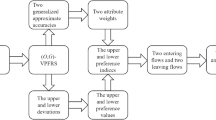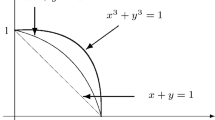Abstract
In this paper, we present a new approach for defining a dual proximity measure for intuitionistic fuzzy sets. The new approach utilizes an extended form of the restricted equivalence functions and receives their values as a two tuple. The two values in the two tuple are due to the dual character of the proximity measure under consideration. In fact, the computation of proximity between two intuitionistic fuzzy sets simultaneously provides the value of similarity as well as non-similarity between the intuitionistic fuzzy sets. So, the novel approach proposed in this paper provides a comprehensive information theoretic evaluation of intuitionistic fuzzy sets. Further, we investigate the application of the novel measure in pattern recognition and clustering analysis. We also contrast the performance of the proposed measure with the state-of-art in view of the structured linguistic variables, pattern classification and clustering analysis. The comparative analysis shows that the newly introduced two-valued proximity measure performs better in certain circumstances and encompasses the dualism of the human cognition.











Similar content being viewed by others
Data Availability
The findings of this study are supported by artificially generated data and can directly be referred from this paper.
References
Atanassov KT (1986) Intuitionistic fuzzy sets. Fuzzy Sets Syst 20:87–96
Atanassov KT (1989) More on intuitionistic fuzzy sets. Fuzzy Sets Syst 33(1):37–45. https://doi.org/10.1016/0165-0114(89)90215-7
Atanassov KT (2012) On intuitionistic fuzzy sets theory. Springer
Bustince H, Barrenechea E, Pagola M, Fernandez J, Guerra C, Couto P, Melo-Pinto P (2011) Generalized Atanassov’s intuitionistic fuzzy index: Construction of Atanassov’s fuzzy entropy from fuzzy implication operators. Int J Uncertain Fuzz Knowl-Based Syst 19(01):51–69. https://doi.org/10.1142/S0218488511006885
Burillo P, Bustince H (1996) Entropy on intuitionistic fuzzy sets and on interval-valued fuzzy sets. Fuzzy Sets Syst 78(3):305–316
Bustince H, Barrenechea E, Pagola M (2008) Relationship between restricted dissimilarity functions, restricted equivalence functions and normal EN-functions: image thresholding invariant. Pattern Recognit Lett 29(4):525–536. https://doi.org/10.1016/j.patrec.2007.11.007
Bustince H, Barrenechea E, Pagola M (2006) Restricted equivalence functions. Fuzzy Sets Syst 157(17):2333–2346. https://doi.org/10.1016/j.fss.2006.03.018
Bustince H, Montero J, Barrenechea E, Pagola M (2007) Semiautoduality in a restricted family of aggregation operators. Fuzzy Sets Syst 158(12):1360–1377. https://doi.org/10.1016/j.fss.2007.02.007
Boran FE, Akay D (2014) A biparametric similarity measure on intuitionistic fuzzy sets with applications to pattern recognition. Inf Sci 255:45–57. https://doi.org/10.1016/j.ins.2013.08.013
Chen SM (1995) Measures of similarity between vague sets. Fuzzy Sets Syst 74(2):217–223. https://doi.org/10.1016/0165-0114(94)00339-9
Chen SM (1995) Measures of similarity between vague sets. Fuzzy Sets Syst 74(2):217–223. https://doi.org/10.1016/0165-0114(94)00339-9
Chen SM, Cheng SH, Lan TC (2016) A novel similarity measure between intuitionistic fuzzy sets based on the centroid points of transformed fuzzy numbers with applications to pattern recognition. Inf Sci 343:15–40. https://doi.org/10.1016/j.ins.2016.01.040
Cornelis C, Deschrijver G, Kerre EE (2004) Implication in intuitionistic fuzzy and interval-valued fuzzy set theory: construction, classification, application. Int J Approx Reason 35(1):55–95. https://doi.org/10.1016/S0888-613X(03)00072-0
Calvo T, Mayor G, Mesiar R (2002). Aggregation operators: new trends and applications. Springer Science and Business Media
De Luca A, Termini S (1972) A definition of a non probabilistic entropy in the setting of fuzzy sets theory. Inf Control 20(4):301–312
Dengfeng L, Chuntian C (2002) New similarity measures of intuitionistic fuzzy sets and application to pattern recognitions. Pattern Recognit Lett 23(1–3):221–225. https://doi.org/10.1016/S0167-8655(01)00110-6
De SK, Biswas R, Roy AR (2000) Some operations on intuitionistic fuzzy sets. Fuzzy Sets Syst 114(3):477–484. https://doi.org/10.1016/S0165-0114(98)00191-2
Dubois D, Prade H (1985) A review of fuzzy set aggregation connectives. Inf Sci 36(1–2):85–121. https://doi.org/10.1016/0020-0255(85)90027-1
Fan L, Zhangyan X (2001) Similarity measures between vague sets. J Syst Softw 12:922–927
Farhadinia B (2013) A theoretical development on the entropy of interval-valued fuzzy sets based on the intuitionistic distance and its relationship with similarity measure. Knowl-Based Syst 39:79–84. https://doi.org/10.1016/j.knosys.2012.10.006
Fodor J C, Roubens M R (1994) Fuzzy preference modelling and multicriteria decision support. Springer Science and Business media
Garg H, Kumar K (2018) Distance measures for connection number sets based on set pair analysis and its applications to decision-making process. Appl Intell 48(10):3346–3359. https://doi.org/10.1007/s10489-018-1152-z
Ganie AH, Singh S (2021) A picture fuzzy similarity measure based on direct operations and novel multi-attribute decision-making method. Neural Comput Appl 33(15):1–21. https://doi.org/10.1007/s00521-020-05682-0
Ganie AH, Singh S, Bhatia PK (2020) Some new correlation coefficients of picture fuzzy sets with applications. Neural Comput Appl 32(16):1–17. https://doi.org/10.1007/s00521-020-04715-y
Ganie AH, Singh S (2021) An innovative picture fuzzy distance measure and novel multi-attribute decision-making method. Complex Intell Syst 7(2):781–805. https://doi.org/10.1007/s40747-020-00235-3
Guo K (2015) Knowledge measure for atanassov’s intuitionistic fuzzy sets. IEEE Trans Fuzzy Syst 24(5):1072–1078. https://doi.org/10.1109/TFUZZ.2015.2501434
Guo K, Song Q (2014) On the entropy for Atanassov’s intuitionistic fuzzy sets: an interpretation from the perspective of amount of knowledge. Appl Soft Comput 24:328–340. https://doi.org/10.1016/j.asoc.2014.07.006
Hatzimichailidis AG, Papakostas GA, Kaburlasos VG (2012) A novel distance measure of intuitionistic fuzzy sets and its application to pattern recognition problems. Int J Intell Syst 27(4):396–409. https://doi.org/10.1002/int.21529
Hung WL, Yang MS (2006) Fuzzy entropy on intuitionistic fuzzy sets. Int J Intell Syst 21(4):443–451. https://doi.org/10.1002/int.20131
Hung WL, Yang MS (2004) Similarity measures of intuitionistic fuzzy sets based on hausdorff distance. Pattern Recognit Lett 25(14):1603–1611. https://doi.org/10.1016/j.patrec.2004.06.006
Hung WL, Yang MS (2008) On similarity measures between intuitionistic fuzzy sets. Int J Intell Syst 23(3):364–383. https://doi.org/10.1002/int.20271
Hong DH, Kim C (1999) A note on similarity measures between vague sets and between elements. Inf Sci 115(1–4):83–96. https://doi.org/10.1016/S0020-0255(98)10083-X
Iancu I (2014) Intuitionistic fuzzy similarity measures based on Frank t-norms family. Pattern Recognit Lett 42:128–136. https://doi.org/10.1016/j.patrec.2014.02.010
Jiang Q, Jin X, Lee SJ, Yao S (2019) A new similarity/distance measure between intuitionistic fuzzy sets based on the transformed isosceles triangles and its applications to pattern recognition. Expert Syst Appl 116:439–453. https://doi.org/10.1016/j.eswa.2018.08.046
Zadeh LA (1965) Fuzzy sets inf. Control 8:338–353
Lalotra S, Singh S (2018) On a knowledge measure and an unorthodox accuracy measure of an intuitionistic fuzzy sets with their applications. Int J Comput Intell 11(1):1338–1356
Liang Z, Shi P (2003) Similarity measures on intuitionistic fuzzy sets. Pattern Recognit Lett 24(15):2687–2693. https://doi.org/10.1016/S0167-8655(03)00111-9
Li J, Deng G, Li H, Zeng W (2012) The relationship between similarity measure and entropy of intuitionistic fuzzy sets. Inf Sci 188:314–321. https://doi.org/10.1016/j.ins.2011.11.021
Li F, Xu Z (2001) Measures of similarity between vague sets. J Softw 12(6):922–927
Li Y, Zhongxian C, Degin Y (2002) Similarity measures between vague sets and vague entropy. J Sci Comput 29(12):129–132
Liu XD, Zheng SH, Xiong FL (2005). Entropy and subsethood for general interval-valued intuitionistic fuzzy sets. In: international conference on fuzzy systems and knowledge discovery. Springer, Berlin, Heidelberg, pp 42–52
Mitchell HB (2003) On the Dengfeng-chuntian similarity measure and its application to pattern recognition. Pattern Recognit Lett 24(16):3101–3104. https://doi.org/10.1016/S0167-8655(03)00169-7
Pal NR, Bustince H, Pagola M, Mukherjee UK, Goswami DP, Beliakov G (2013) Uncertainties with atanassov’s intuitionistic fuzzy sets: fuzziness and lack of knowledge. Inf Sci 228:61–74. https://doi.org/10.1016/j.ins.2012.11.016
Rakić D, Došenović T, Mitrović ZD, de la Sen M, Radenović S (2020) Some fixed point theorems of Ćirić type in fuzzy metric spaces. Mathematics 8(2):297. https://doi.org/10.3390/math8020297
Rakić D, Mukheimer A, Došenović T, Mitrović ZD, Radenović S (2020) On some new fixed point results in fuzzy b-metric spaces. J Inequalities Appl 1:1–14. https://doi.org/10.1186/s13660-020-02371-3
Rojas-Thomas JC, Santos M (2021) New internal clustering validation measure for contiguous arbitrary-shape clusters. Int J Intell Syst 36(10):5506–5529. https://doi.org/10.1002/int.22521
Singh S, Ganie AH, Lalotra S (2021) On generalized correlation coefficients of picture fuzzy sets with their applications. Int J Fuzzy Syst Appl 10(2):59–81
Singh S, Ganie AH (2022) Two-parametric generalized fuzzy knowledge measure and accuracy measure with applications. Int J Intell Syst 37(7):3836–3880. https://doi.org/10.1002/int.22705
Singh S, Ganie AH (2021) Applications of picture fuzzy similarity measures in pattern recognition, clustering, and MADM. Expert Syst Appl 168:114–264. https://doi.org/10.1016/j.eswa.2020.114264
Singh S, Sharma S (2021) On a generalized entropy and dissimilarity measure in intuitionistic fuzzy environment with applications. Soft Comput 25(11):7493–7514. https://doi.org/10.1007/s00500-021-05709-1
Song Y, Wang X, Lei L, Xue A (2015) A novel similarity measure on intuitionistic fuzzy sets with its applications. Appl Intell 42(2):252–261. https://doi.org/10.1007/s10489-014-0596-z
Song Y, Wang X, Quan W, Huang W (2019) A new approach to construct similarity measure for intuitionistic fuzzy sets. Soft Comput 23(6):1985–1998. https://doi.org/10.1007/s00500-017-2912-0
Szmidt E, Kacprzyk J (2004) A similarity measure for intuitionistic fuzzy sets and its application in supporting medical diagnostic reasoning. In: international conference on artificial intelligence and soft computing. Springer, Berlin, Heidelberg, pp 388–393
Szmidt E, Kacprzyk J (2007) Some problems with entropy measures for the atanassov intuitionistic fuzzy sets. International workshop on Fuzzy Logic and Applications, Springer, Berlin, Heidelberg
Szmidt E, Kacprzyk J, Bujnowski P (2014) How to measure the amount of knowledge conveyed by atanassov’s intuitionistic fuzzy sets. Inf Sci 257:276–285. https://doi.org/10.1016/j.ins.2012.12.046
Szmidt E, Kacprzyk J (2000) Distances between intuitionistic fuzzy sets. Fuzzy Sets Syst 114(3):505–518. https://doi.org/10.1016/S0165-0114(98)00244-9
Szmidt E, Kacprzyk J (2001) Entropy for intuitionistic fuzzy sets. Fuzzy Sets Syst 118(3):467–477. https://doi.org/10.1016/S0165-0114(98)00402-3
Vlachos IK, Sergiadis GD (2007) Subsethood, entropy, and cardinality for interval-valued fuzzy sets-an algebraic derivation. Fuzzy Sets Syst 158(12):1384–1396. https://doi.org/10.1016/j.fss.2006.12.018
Wei CP, Wang P, Zhang YZ (2011) Entropy, similarity measure of interval-valued intuitionistic fuzzy sets and their applications. Inf Sci 181(19):4273–4286. https://doi.org/10.1016/j.ins.2011.06.001
Wang JQ, Wang P (2012) Intuitionistic linguistic fuzzy multi-criteria decision-making method based on intuitionistic fuzzy entropy. J Control Decis 27(11):1694–1698
Wu D, Lu J, Zhang G (2011) Similarity measure models and algorithms for hierarchical cases. Expert Syst Appl 38(12):15049–15056. https://doi.org/10.1016/j.eswa.2011.05.040
Xu Z (2007) Intuitionistic fuzzy aggregation operators. IEEE Trans Fuzzy Syst 15(6):1179–1187. https://doi.org/10.1109/TFUZZ.2006.890678
Yager RR (1979) On the measure of fuzziness and negation part I: membership in the unit interval. Int J Gen Syst 5(4):221–229. https://doi.org/10.1080/03081077908547452
Ye J (2011) Cosine similarity measures for intuitionistic fuzzy sets and their applications. Math Comput Model 53(1–2):91–97. https://doi.org/10.1016/j.mcm.2010.07.022
Ye J (2012) Multicriteria decision-making method using the Dice similarity measure based on the reduct intuitionistic fuzzy sets of interval-valued intuitionistic fuzzy sets. Appl Math Model 36(9):4466–4472. https://doi.org/10.1016/j.apm.2011.11.075
Zeng W, Li H (2006) Relationship between similarity measure and entropy of interval valued fuzzy sets. Fuzzy Sets Syst 157(11):1477–1484. https://doi.org/10.1016/j.fss.2005.11.020
Zhang QS, Jiang SY (2008) A note on information entropy measures for vague sets and its applications. Inf Sci 178(21):4184–4191. https://doi.org/10.1016/j.ins.2008.07.003
Zhang H, Zhang W, Mei C (2009) Entropy of interval-valued fuzzy sets based on distance and its relationship with similarity measure. Knowl-Based Syst 22(6):449–454. https://doi.org/10.1016/j.knosys.2009.06.007
Zhang H, Yu L (2013) New distance measures between intuitionistic fuzzy sets and interval-valued fuzzy sets. Inf Sci 245:181–196. https://doi.org/10.1016/j.ins.2013.04.040
Acknowledgements
Authors are highly thankful to the anonymous reviewers for their constructive suggestions and bringing the paper in the present form.
Author information
Authors and Affiliations
Corresponding author
Ethics declarations
Conflicts of interest
Authors declare that there is no conflict of interest.
Ethical approval
The present article does not contain any studies with human participants or animals performed by any of the authors.
Additional information
Publisher's Note
Springer Nature remains neutral with regard to jurisdictional claims in published maps and institutional affiliations.
Rights and permissions
Springer Nature or its licensor (e.g. a society or other partner) holds exclusive rights to this article under a publishing agreement with the author(s) or other rightsholder(s); author self-archiving of the accepted manuscript version of this article is solely governed by the terms of such publishing agreement and applicable law.
About this article
Cite this article
Singh, K., Singh, S. On a dual proximity measure based on intuitionistic fuzzy sets. Neural Comput & Applic 35, 6293–6311 (2023). https://doi.org/10.1007/s00521-022-07946-3
Received:
Accepted:
Published:
Issue Date:
DOI: https://doi.org/10.1007/s00521-022-07946-3




